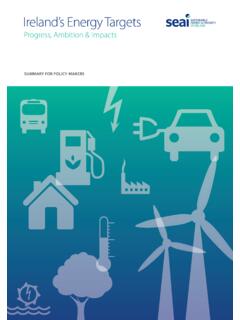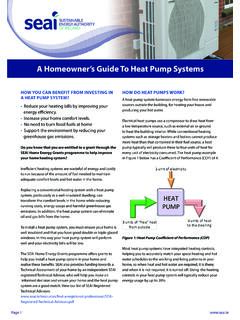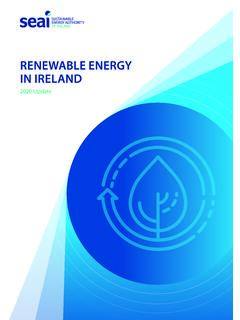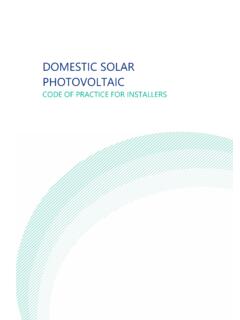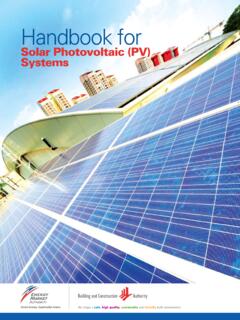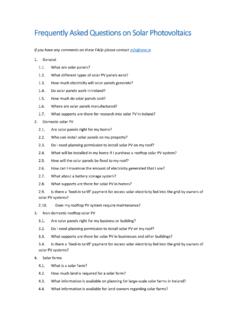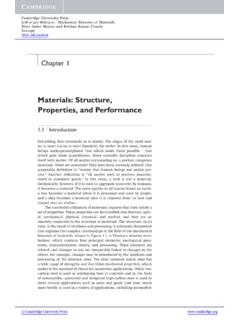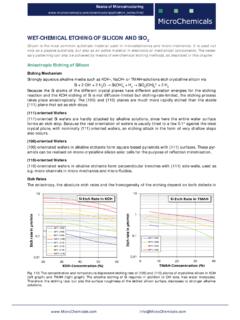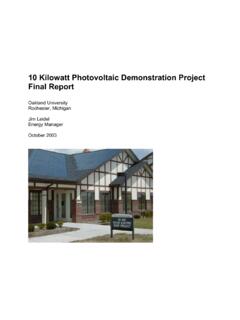Transcription of Best Practice Guide Photovoltaics (PV) - SEAI
1 Best Practice Guide Photovoltaics (PV)Best Practice Guide Photovoltaics (PV)2 Best Practice Guide Photovoltaics (PV)Acknowledgements:This Guide was adapted from Photovoltaics in Buildings A Design Guide (DTI), Guide to the installation of PV systems 2nd Edition the Department for Enterprise DTI/Pub URN 06/1972. Note to readers:One intention of this publication is to provide an overview for those involved in building and building services design and for students of these disciplines. It is not intended to be exhaustive or definitive and it will be necessary for users of the Guide to exercise their own professional judgement when deciding whether or not to abide by it.
2 It cannot be guaranteed that any of the material in the book is appropriate to a particular use. Readers are advised to consult all current Building Regulations, EN Standards or other applicable guidelines, Health and Safety codes, as well as up-to-date information on all materials and products. Best Practice Guide Photovoltaics (PV)3 Best Practice Guide Photovoltaics (PV)3 Index1 Introduction .. 42 What are Photovoltaics ? .. Introduction .. PVs .. How much energy do PV systems produce? .. Location, tilt, orientation and output.
3 Over shading and temperature .. 193 PVs on buildings .. Introduction .. The Brief .. Site considerations .. Building type .. Design and construction .. Forms and systems .. Roof-based systems .. Facade systems .. What difference do PVs make? .. 324 Costs and sizing .. Introduction .. Costs .. Sizing the array .. The future of costs .. 395 PVs in buildings .. Introduction .. Grid-connection and metering .. System considerations .. Modules and cables .. Plant / Equipment Rooms.
4 486 Case Study .. Introduction .. Site and brief .. Design development .. Future detailed design .. Project data .. 617 Appendix A .. 628 References and Bibliography .. 699 Glossary .. 6910 Illustration Acknowledgements .. 7011 Contact .. 70 Best Practice Guide Photovoltaics (PV)41 Introduction If the 19th century was the age of coal and the 20th of oil, the 21st will be the age of the sun. Solar energy is set to play an ever-increasing role in generating the form, and affecting the appearance and construction, of buildings.
5 The principal reason for this is that photovoltaic (PV) systems which produce electricity directly from solar radiation are becoming more widespread as their advantages become apparent and as costs fall. PVs are an advanced materials technology that will help us design buildings which are environmentally responsible, responsive and exciting. PV installations can take a variety of forms as shown in the following figures. Best Practice Guide Photovoltaics (PV)5 There are many applications for PVs and some are already in widespread use here in Ireland.
6 Others represent potential uses that are likely to be seen in the near future. These are listed in the table below:End usersTypical ApplicationsWaterway Authorities / Environmental Protection AgencyLock & Sluice operationWater pumpingWater quality monitoringLocal AuthoritiesParking metersCar park security lightingStreet / path lightingBus stop and shelter lightingRoad AuthoritiesEmergency phonesRoadside information and hazard warning signsMobile units for temporary warning signsSpeed camerasRemote junction / crossroads lightingPowered cats eyesTraffic and pollution monitoringRail NetworkRemote rail stations lightingPoint
7 GreasersSignalling and warning signsHarbour & Light House AuthoritiesLighthousesOffshore (buoy-mounted) navigation beaconsHarbour navigation beacons and warning signsMet OfficeWeather stations wind speed, temperature etcAir quality monitoringHeritage and National Monument SitesRemote visitor centresYouth HostelsRemote hostelsUniversities / Research LaboratoriesRemote monitoring equipmentGas / Electricity / Water Utility Companies / SuppliersRemote meter readingPressure and flow measurementValve operationAnti-freeze heatingMonitoring HV cable insulationWater level measurementWater treatment.
8 Pumping and purificationPhone Network OperatorsMobile phone local transmittersTelecoms repeater stationsFarming & AgricultureElectric fencingPest control flashing lights, bird scarersWater pumping for livestock & drinking waterLighting for stables and out-housesFish farm pond aerationFish farm feeding systemsGreenhouse lighting and heatingBest Practice Guide Photovoltaics (PV)6 End usersTypical ApplicationsDomestic BuildingsLighting and general powerIndustrial BuildingsLighting, general power and process equipmentGeneralAlarms for remote buildingsArea lightingCCTVA dvertisingLeisure BoatsElectric boat battery chargingBattery charging (lighting & TV)Camping & Remote HomesBattery charging (lighting & TV)Commercial BuildingsLighting and general powerTable.
9 Typical applications of photo voltaic technology1 Many of the applications listed in the table above can be considered small scale. Application of PVs in buildings has a very large potential and this best Practice Guide is focused on this area of can form part of the roof structure, walls or be floor mounted. Different types will lend themselves to different buildings. This Guide provides an overview of how PVs work and are incorporated in the design of buildings; it gives the information that building owners, designers and, in particular, architects, need.
10 It is for those who wish to assess the feasibility of using PVs in a specific project, for those who have already decided to use PVs and want to know how to do so and for those with the foresight to want to plan their buildings for PVs in the future. New buildings have been addressed especially and covered by a number of building types and sectors; much of the technology could be applied as a retrofit to existing buildings. The focus is on PV systems which are building-integrated and grid-connected. PVs are a proven, commercially-available technology.


